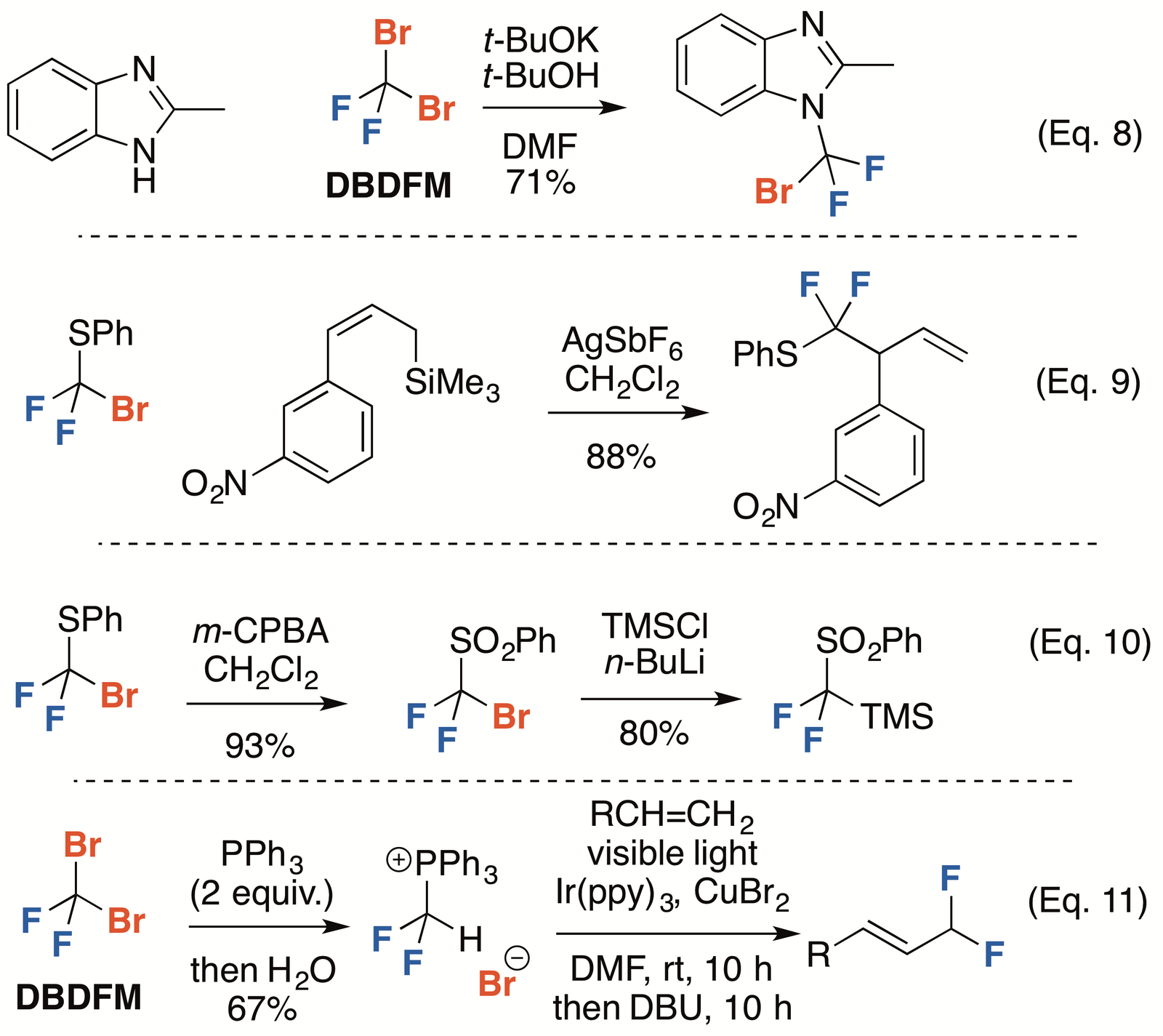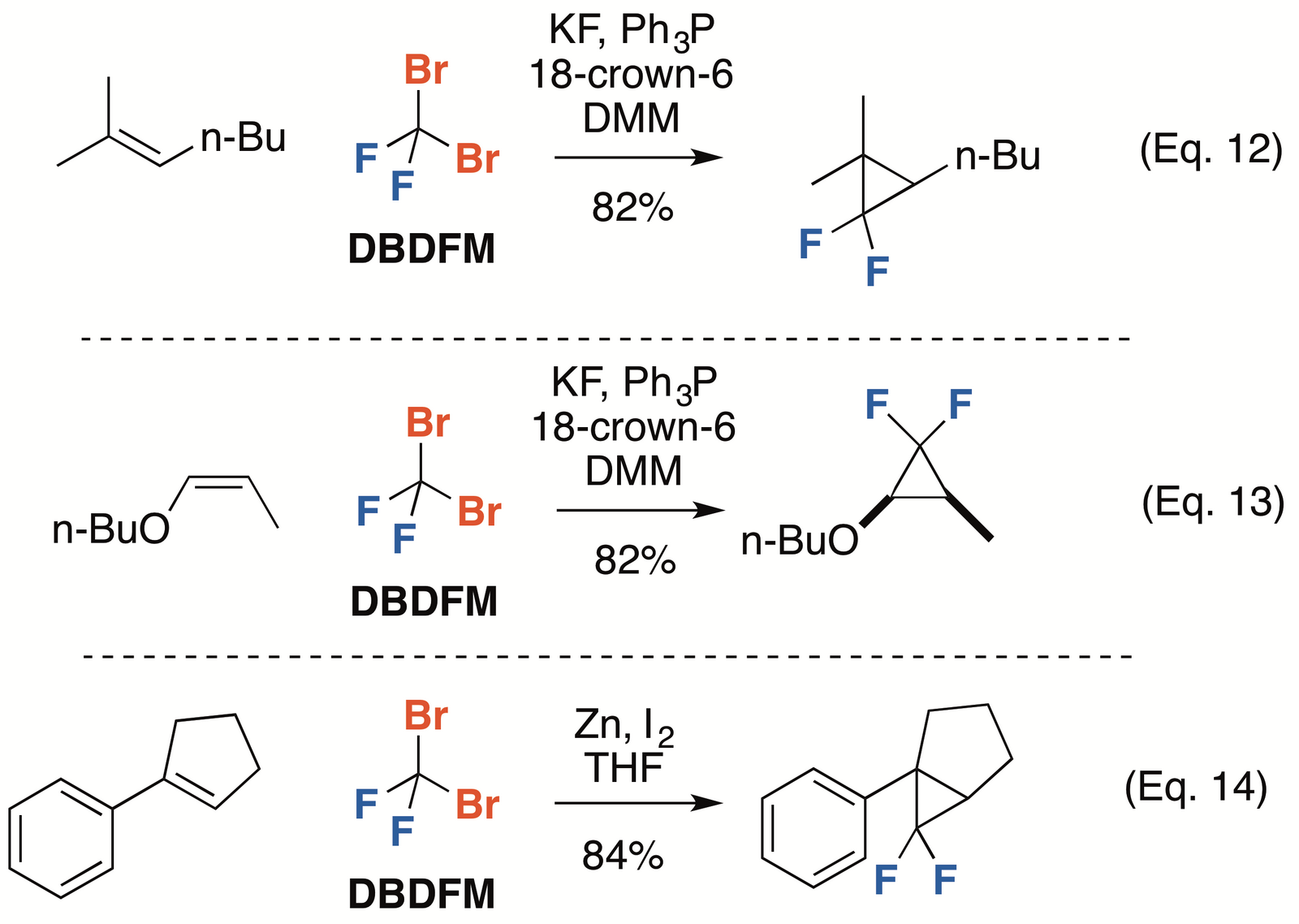Dibromodifluoromethane (DBDFM)
Dibromodifluoromethane (DBDFM) is a useful tool for a wide variety of functionalization – from cyclopropanation to alkylation to the LCD and OLED markets. In many of these transformations, the resultant products contain fluorine. Using proprietary technology, Valliscor manufactures kilogram to commercial scale of high purity DBDFM (>98% pure) for the pharmaceutical industry in its Corvallis, Oregon production facility.
Alternate Names: DBDFM, difluorodibromomethane, Halon 1202, Fluorocarbon 12-B2, FC 12-B2, R 12B2, UN 1941, Freon 12B2
Catalog #: VCDBDFM
CAS #: 75-61-6
Molecular Weight: 209.82 g/mol
Density: 2.29 g/mL
Boiling Point: 23°C
19F NMR Spectra (CDCl3): 7.00 (s) ppm
Wikipedia Link: Material Safety Data Sheet (MSDS) / Safety Data Sheet (SDS): [DOWNLOAD]
Downloadable Flyer on Valliscor’s Dibromodifluoromethane (DBDFM) Capabilities: [DOWNLOAD]
Olefination of Carbonyls
Numerous examples have been reported for the use of dibromodifluoromethane (DBDFM) for the difluoromethylation of aldehydes using both Zn as the reducing agent (Eq. 1, J. Fluorine Chem. 2012, 143, 177-198) as well as HMPT itself (Eq. 2, J. Fluorine Chem. 2015, 179, 106-115). Numerous other examples of this type of transformation have been reported (e.g., J. Fluorine Chem. 2006, 127, 610-619; Org. Lett. 2015, 17, 1126-1129).
These products derived from dibromodifluoromethane (DBDFM) have been in carbohydrate synthesis where the resultant difluorovinyl moiety is used in incorporate a difluromethyl linker (Eq. 3, J. Am. Chem. Soc. 2007, 129, 15420-15421) and nucleosides where the resultant difluorovinyl moiety is hydrogenated to access a difluoromethyl group (Eq. 4, J. Org. Chem. 2005, 70, 3826-3837). Additional applications include as carbonyl mimics (J. Am. Chem. Soc. 2003, 125, 6348-5349) and sugar mimesis (Angew. Chem. Int. Ed. 2004, 43, 6680-6683).
Alkylation by Nucleophiles
Dibromodifluoromethane (DBDFM) performs as an excellent electrophile in a range of SN2-type transformations. Hammond has demonstrated numerous examples for accessing propargylic bromodifluoromethyl moieties (Eq. 5, J. Fluorine Chem. 2006, 127, 476-488). The products from these alkynylations can be applied to difluoropropargylations of aldehydes (Eq. 6, J. Org. Chem. 2006, 71, 7261-7267) and the carboynlation of to difluoromethylene esters (Eq. 7, Org. Lett. 2007, 9, 4251-4253).
Heteroatom nucleophiles are equally effective with dibromodifluoromethane (DBDFM). Nitrogen-based nucleophiles such as benzimidazoles (Eq. 8, J. Fluorine Chem. 2001, 109, 173-181) as well as imidazole and indazole (J. Fluorine Chem. 2000, 106, 181-187). Sulfur-based nucleophiles and selenide-based nucleophiles such as sodium phenylsulfide and sodium phenylselenide cleanly react with DBDFM (PhSCBrF2: 85% yield, ; PhSeCBrF2: 81% yield, Org. Lett. 2013, 15, 5666-5669). These reagent can be further reactive with various nucleophile such as allyl silanes (Eq. 9, Org. Lett. 2013, 15, 5666-5669). Alternatively, the sulfide can be oxidized followed by displacement to access an difluromethyl sulfone silane reagent (Eq. 10, Angew. Chem. Int. Ed. 2016, 55, 4790-4793). Phosphorus is also an excellent nucleophile for DBDFM. Following a protocol analogous to preparing the Corey-Fuchs reagent, treatment with PPh3 (2 equiv.) followed by the addition of water generates the difluoromethyl phosphonium salt (Eq. 11, Org. Lett. 2016, 18, 2419-2422). This phosphoniums salt proved useful in an Ir-catalyzed addition radical addition of CHF2 and Br across alkenes. The elements of HBr can be eliminated from these products to access difluoromethyl alkenes (Eq. 11).
Cyclopropanation
Dibromodifluoromethane (DBDFM) can also be used for cyclopropanations (Eq. 12-14). Cyclopropanation is possible on both acyclic and cyclic alkenes (Eq. 12-13, Tetrahedron 1990, 46, 4213-4221). Additionally, these cyclopropantions are stereospecific with respect to olefin geometry as shown in this Simmons Smith protocol (Eq. 14, J. Org. Chem. 1990, 55, 5420-5422).
LCD & OLED Displays
Dibromodifluoromethane (DBDFM) has been reported in numerous patents as a potential component for use in LCD and OLED displays. Select examples include the following corporations and governments:
Chisso Corporation: US6187223B1, WO2007066755A1, EP202853A1, US20090065739
JNC Corporation: CN102186821B, EP2433923A4
Czech NXP Corporation: CN104334687
UK Government: US3947375

J. Fluorine Chem. 2012, 143, 177-198 (Eq. 1); J. Fluorine Chem. 2015, 179, 106-115(Eq. 2).

J. Am. Chem. Soc. 2007, 129, 15420-15421 (Eq. 3); J. Org. Chem. 2005, 70, 3826-3837 (Eq. 4)

J. Fluorine Chem. 2006, 127, 476-488 (Eq. 5); J. Org. Chem. 2006, 71, 7261-7267 (Eq. 6); Org. Lett. 2007, 9, 4251-4253 (Eq. 7)

J. Fluorine Chem. 2001, 109, 173-181 & J. Fluorine Chem. 2000, 106, 181-187 (Eq. 8); Org. Lett. 2013, 15, 5666-5669 (Eq. 9); Angew. Chem. Int. Ed. 2016, 55, 4790-4793 (Eq. 10); Org. Lett. 2016, 18, 2419-2422 (Eq. 11)

Tetrahedron 1990, 46, 4213-4221 (Eq. 12-13); J. Org. Chem. 1990, 55, 5420-5422 (Eq. 14)

